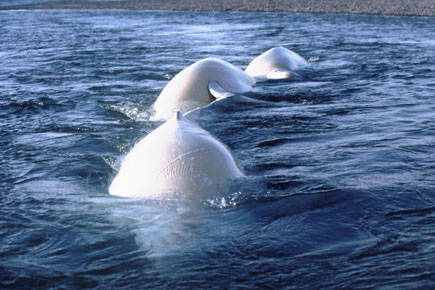What is killing our belugas?
What would you do if your grocery store didn’t have any groceries? How long would it take you to develop a food emergency? Our oceans are trying to survive human industrialization but they are stumbling. Marine life is being sold worldwide at unprecedented levels.
Cook Inlet beluga whales prey primarily on sockeye salmon in July in order to acquire enough body weight to survive the winter. This (July fat increase) must happen at the same time Cook Inlet’ s commercial fisheries spread about 7 million linear feet of gill nets in front of the salmon migrating up Cook Inlet. Commercial fisheries harvest about 90% of these surplus salmon annually, leaving about 10% for public fisheries.
Beluga whales need about 44 pounds of salmon daily in July to put on enough body fat to survive the winter. Failure to consume this fat cannot be made up with extra hunting. Not much moves up Cook Inlet the rest of the year, so they either feast in July or starve later. A beluga needs to consume about five sockeye per day to achieve this 44 pounds of fat.
Beluga whales weigh from 2,000-3,000 pounds and five sockeye per day times 31 days in July equals 155 salmon. They each require 155 sockeye annually to achieve minimum fat reserves to survive the winter. Three hundred belugas require 46,500 sockeye, 600 require 93,000 sockeyes and so on. You can have as many belugas as you want to feed.
Cook Inlet can get from 2-6 million sockeye per year. A surplus of 5 million sockeye allocates commercial fisheries 4.5 million sockeye at 90% and public fisheries 500,000 sockeye at 10%. This is a 100% allocation, leaving zero for belugas — unless they somehow steal from sockeye escapements.
With 46,500 sockeyes required and zero available, it’s apparent there’s serious problem. Current 100% sockeye allocation guarantees we either destroy our sockeyes to maintain belugas or destroy our belugas to maintain sockeyes. No matter the size of a sockeye run, a fully allocated resource requires us to sacrifice either sockeyes or belugas.
Without a specific beluga sockeye allocation, Cook Inlet’s belugas will go extinct. This is a Board of Fisheries problem but they are ignoring it. You don’t need to actually starve them to death to eventual kill them. Starvation stress increases strandings, decreases reproduction and increases mortality. Nature senses declining resources and automatically declines reproduction to match it. It turns out that our beluga problem is U.S. selling their prey and spending the money on studies to determine what killed them.
— Donald Johnson, Soldotna

